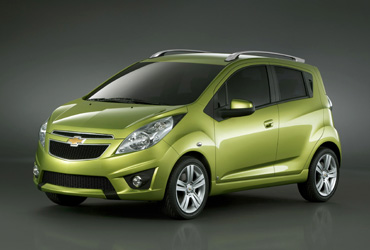
GENEVA – General Motors Co. will manufacture a new small sedan, to be engineered in Brazil, at the General Motors Uzbekistan YoAJ joint-venture plant in Asaka.
The car is part of a family of upcoming “global small vehicles for emerging markets,” GM says.
“It will have a 4-door body, and we will look at variants later on, depending on how market requirements develop,” Michael Arcamone, GM Daewoo Auto & Technology Co. President and CEO, tells Ward’s here.
“Some markets require hatchbacks; some don't. But this is all a couple of years away. As the market changes, we will be able to offer different variants of the vehicle.”
In addition to overseeing GM’s South Korean subsidiary, Arcamone also serves as chairman of the supervisory board of GM Powertrain Uzbekistan and serves on the board of GM-Uzbekistan, which produces several GMDAT vehicles using components from Korea.
GMDAT and AK UzAvtoSanoat, the Uzbek state auto industry company and GM’s JV partner, signed an operational memorandum of understanding about the project in February. GM holds a 25% share in the JV.
Arcamone says the upcoming sedan will compete with other low-cost brands, such as the Dacia/Renault Logan. It also will be a bit longer than the Chevy Spark.
“It will be a small vehicle sold under the Chevrolet brand, and it will be packaged for customer needs in emerging markets,” he says. “In other words, we will be tailoring the vehicle in terms of content to meet the expectations and budgets of customers in emerging markets.”
“We are looking at market introduction probably by 2012 or 2013 and could start production by 2012,” Arcamone says when asked about the project timing.

GM Uzbekistan will make the small sedan for sale in Uzbekistan, Russia and other Commonwealth of Independent States countries. “It is also to be built in Brazil for salesin South America,” Arcamone says, adding the lead plant will be in Brazil, where the car will be engineered.
GM also is studying the possibility of selling the car in Mexico, South Africa and the Middle East. However, there currently is no plan to build the new models in other Asian countries outside Uzbekistan.
That means the new sedan will be the first model to be built by the Uzbek plant that is not already manufactured in South Korea.
GM Uzbekistan produces four GMDAT models – the Matiz minicar, Lacetti and Nexia sedans and Damas mini-commercial vans. Depending on model and market, the vehicles are sold under the Chevrolet or Daewoo badge.
In addition, Chevrolet models are assembled in small volumes from semi-knocked-down kits at a separate site in the capital of Tashkent.
Preparations also are under way at the Uzbek plant for production of the new Chevrolet Spark.
“The SOP is scheduled to take place between September and October this year,” Arcamone says. “We will be launching the Spark on the Uzbek market and will also be exporting the car to Russia and other CIS countries.”
The Matiz and Nexia models are sold under the Daewoo brand in Russia, GM Uzbekistan’s largest export market. The Spark will be the first Uzbek-made car sold in Russia as a Chevrolet.
Uzbek production of the Matiz will continue, despite the launch of the Spark. “We will build both vehicles for the time being,” Arcamone says, noting it has not been decided how long the Matiz will be exported to Russia. But there are no plans to sell Uzbek-made cars outside of the CIS countries.
“The local content is 50%, as we have to meet the 50% localization rule,” Arcamone says.
Local content of Asaka-made cars will be even higher when the new engine plant, GM Powertrain Uzbekistan YoAJ, owned 52% by GM and currently under construction in Tashkent, launches production. The facility will make 1.2L and 1.5L gasoline engines.
“The start of production on the first engine will probably be in the last quarter of 2011, and the second maybe four to six months later,” Arcamone says.
In contrast to GM’s other plants, the Uzbek facility also will make aluminium cylinder heads.
“This will be the first cylinder head manufactured in-house by GM between Europe and Asia,” Arcamone says. “And we will be doing it at a very competitive price and at the same high quality. We are actually in-sourcing from the supply base, which is very interesting.”
GM plans to increase capacity and production volumes at the Asaka car plant. “As soon as we launch the Spark, we will be surpassing 200,000 (units annually), going to 250,000 units. And when we bring in the ‘global small vehicle’ and other products, this will bring us close to 300,000 vehicles a year,” he says.
Despite the global economic crisis, GM Uzbekistan produced and assembled 205,011 vehicles in 2009, up 5.1% from 2008.
While sales of Daewoo-badged cars made in Uzbekistan tumbled 46.2% to 51,414 in Russia last year, they increased significantly on their home turf, where they are marketed under both Chevrolet and Daewoo nameplates.
“(GM) sold 136,000 vehicles in Uzbekistan last year, so it was indeed able to make up for the loss in Russia with these higher domestic sales,” Arcamone says. “There is a 2-year waiting list for our cars in Uzbekistan.”
The plant's most-produced model last year was the Chevy/Daewoo Nexia (90,650 units), followed by the Daewoo Matiz (69,130), Daewoo Damas van (23,633) and Chevy Lacetti (19,400). In 2009, the company also assembled 1,100 Chevy Captivas and 1,098 Chevy Epicas from SKD kits.
Plans for 2010 call for the production of about 220,000 vehicles.
“We could sell 140,000 or 150,000 cars in Uzbekistan this year, and if the Russian market starts to pick up, we could easily sell 85,000 to 100,000 units in Russia and other CIS countries,” Arcamone says.



